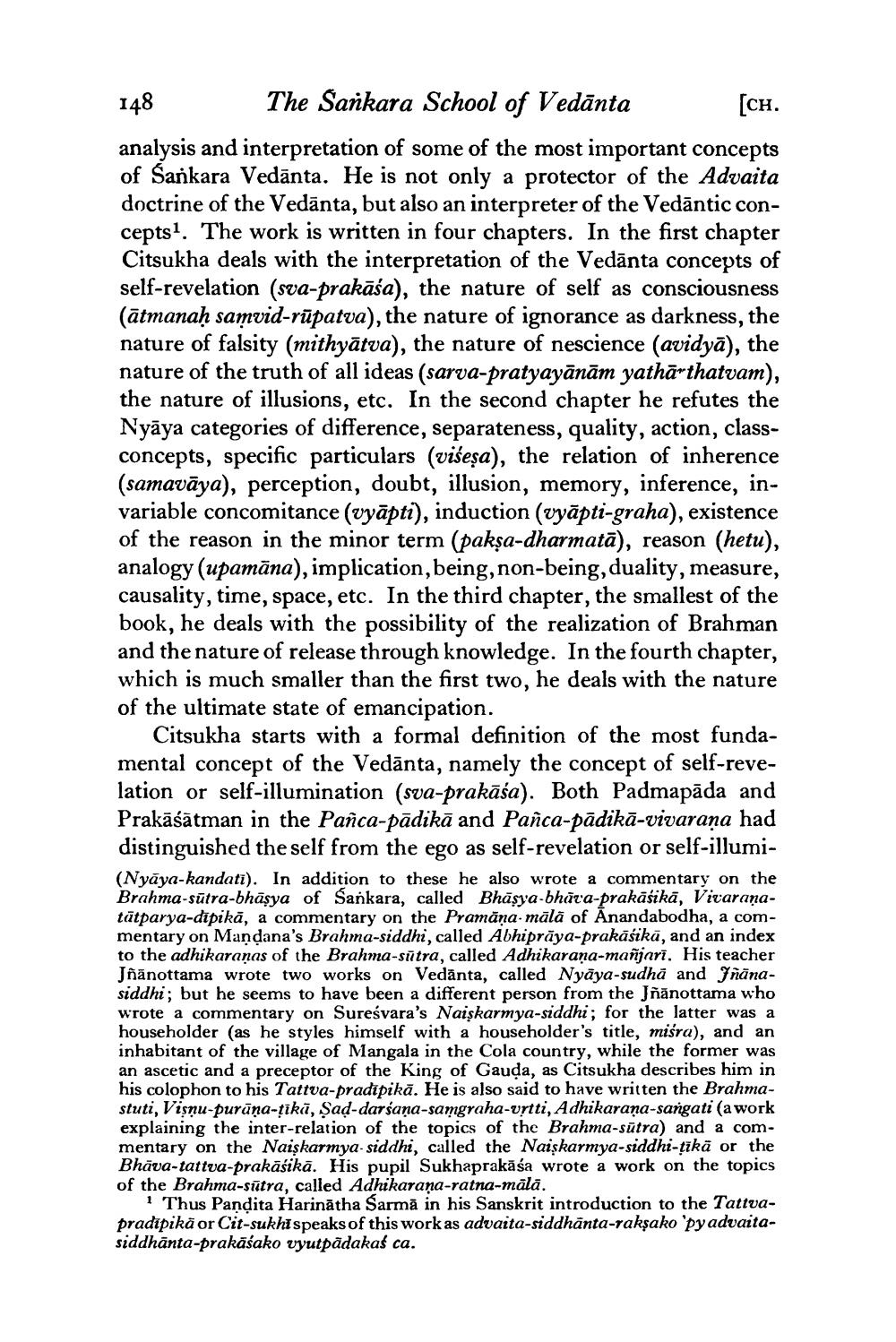________________
148
The Sankara School of Vedānta [CH. analysis and interpretation of some of the most important concepts of Sankara Vedānta. He is not only a protector of the Advaita doctrine of the Vedānta, but also an interpreter of the Vedāntic concepts1. The work is written in four chapters. In the first chapter Citsukha deals with the interpretation of the Vedānta concepts of self-revelation (sva-prakāša), the nature of self as consciousness (ātmanaḥ samvid-rūpatva), the nature of ignorance as darkness, the nature of falsity (mithyātva), the nature of nescience (avidyā), the nature of the truth of all ideas (sarva-pratyayānām yathārthatvam), the nature of illusions, etc. In the second chapter he refutes the Nyāya categories of difference, separateness, quality, action, classconcepts, specific particulars (višeşa), the relation of inherence (samavāya), perception, doubt, illusion, memory, inference, invariable concomitance (vyāpti), induction (vyāpti-graha), existence of the reason in the minor term (pakşa-dharmatā), reason (hetu), analogy (upamāna), implication, being, non-being, duality, measure, causality, time, space, etc. In the third chapter, the smallest of the book, he deals with the possibility of the realization of Brahman and the nature of release through knowledge. In the fourth chapter, which is much smaller than the first two, he deals with the nature of the ultimate state of emancipation.
Citsukha starts with a formal definition of the most fundamental concept of the Vedānta, namely the concept of self-revelation or self-illumination (sva-prakāśa). Both Padmapāda and Prakāśātman in the Panca-pădikā and Panca-pădikā-vivarana had distinguished the self from the ego as self-revelation or self-illumi(Nyāya-kandati). In addition to these he also wrote a commentary on the Brahma-sūtra-bhāsya of Sankara, called Bhāsya-bhāra-prakāśikā, Vivaraņatātparya-dipikā, a commentary on the Pramāņa mālā of Anandabodha, a commentary on Mandana's Brahma-siddhi, called Abhiprāya-prakāśikā, and an index to the adhikaranas of the Brahma-sūtra, called Adhikarana-mañjari. His teacher Jñānottama wrote two works on Vedānta, called Nyāya-sudhā and Inānasiddhi; but he seems to have been a different person from the Jñānottama who wrote a commentary on Sureśvara's Naiskarmya-siddhi; for the latter was a householder (as he styles himself with a householder's title, miśra), and an inhabitant of the village of Mangala in the Cola country, while the former was an ascetic and a preceptor of the King of Gauda, as Citsukha describes him in his colophon to his Tattva-pradipikā. He is also said to have written the Brahmastuti, Visnu-purūna-ţikā, Şad-darsana-samgraha-urtti, Adhikarana-sangati (a work explaining the inter-relation of the topics of the Brahma-sutra) and a commentary on the Naiskarmya-siddhi, called the Naiskarmya-siddhi-tikā or the Bhāva-tattva-prakāśikā. His pupil Sukhaprakāśa wrote a work on the topics of the Brahma-sūtra, called Adhikarana-ratna-mālā.
1 Thus Pandita Harinātha Sarmā in his Sanskrit introduction to the Tattvapradipikā or Cit-sukhispeaks of this work as advaita-siddhanta-rakşako 'py advaitasiddhānta-prakāśako vyutpădakaś ca.




